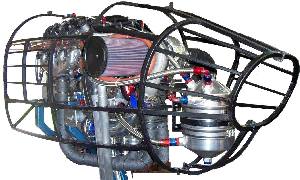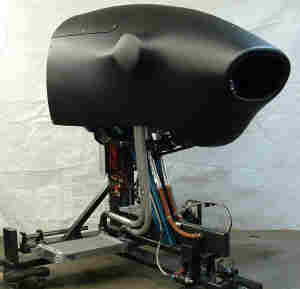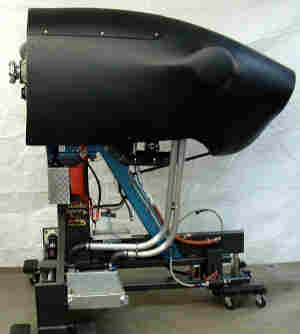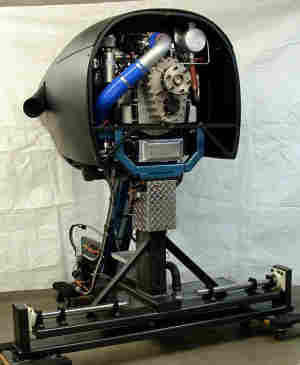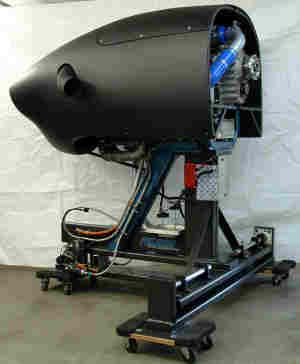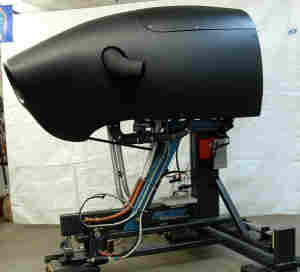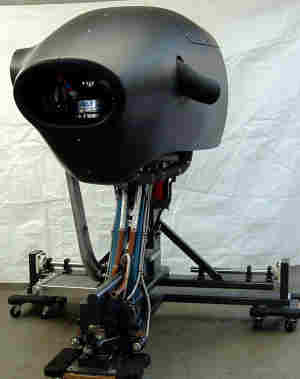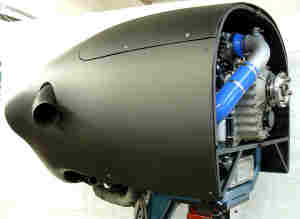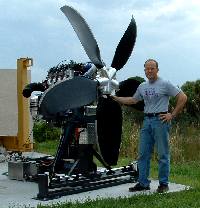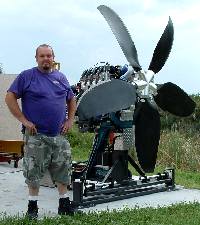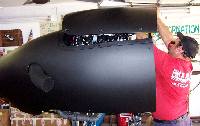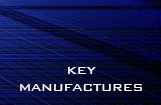WIG Propulsion System
Propulsion System Requirements
Key Members and Supporting Staff
Program History
According to Wikipedia, Ground effect is a generic term describing any aerodynamic effects occurring due to a vehicle's body or appendages moving in close proximity to the ground. Wikipedia goes on the explain the Ground Effect in Aircraft. Using this effect, aircraft designers can develop a craft which can experience greatly reduced drag. This reduced drag can result in greatly increased efficency of operation over typical aircraft and much greater speed than boats.
It is not the purpose of this page to provide a detailed explanation of wing-in-ground effect (WIG) aircraft, as there are already excellent resources for that. The WIG Page, maintained by S.E. Technology, is a notable example. S.E. Technology is an internationally-oriented company that offers products and services related to WIG technology. We highly encourage you to visit The WIG Page if you are interested in the details of these exciting craft. This page relates to South Korea's development of a WIG craft and Cyberspace Automotive Performance's involvement in that effort.
KORDI's WIG project (under the direction of the Maritime and Ocean Engineering Research Institute - MOERI) has prgressed from a vision to radio-controlled models and sub-scale craft. The top-level requirements envisioned by the engineers include:
- 20 Passenger Capability
- Length: 20 Meters (66 Feet)
- Payload: 2 Tons
- Maximum Speed: 200 Km/H (125 MPH)
- Cruise Speec: 150 Km/H (93 MPH)
- Take-off in 2 Meter Wave Height (6 Feet)
- Cruising Height: 2 Meters
- Range: 1000 Km (620 Miles)
- Construction: Aluminum or Composite
Propulsion System Requirements
In order to meet the top-level requirements outlined above, the following specifications were made for the propulsion system:
- 2 Metric Tons (4400 Pounds) of Thrust per Wing at Zero Speed
- Propeller Diameter of 2.18 Meters (86 Inches)
- Ground-Adjustable Pitch
- Push-Type
- Gasoline Piston Engine using Reduction Gear Drive
- Un-Ducted
Initially, it was projected that two engines, presumably large-displacement adaptations of the big-block Chevrolet engine, would be appropriate. After initial consultation between the MOERI engineers and the Cyberspace Automotive Performance (CAP) staff, it was determined that a more efficient, reliable solution could be provided by using four engines.
As part of the deliverable, MOERI requested that a Thrust Test Device be designed as well, and that thrust numbers be provided along with the propulsion system. Finally, to ensure that a product was delivered that could be immediately used, MOERI requested that the propulsion system be delivered with a cowling. All of these requests were within the capability of CAP and it's associates to provide, so the challenge was accepted and work begun.
Design Approach
The project started on Febrary 28, 2007, with a goal to finish in 120 days. The first step was to identify the major components from which the system would be composed. These major components included the engine, the propeller, the reduction drive, the thrust test device, and the cowling.
The Engine
Based on guidance from Mike Felber at Felber Racing Engines, a turbocharged LS2 design was chosen. While MOERI initially had considered a supercharged design, a turbocharged engine was selected for increased reliability and efficiency. Since thrust was the target specification and not horsepower, a turbocharged application gave the potential to select the required horsepower based on the need of the propeller.
The LS2 package provides some of the latest technological advances in General Motors' engines. On top of this already proven powerplant were added several significant upgrades. A dry sump oiling system from Armstrong Race Engineering was added, and the internals were upgraded with Wiseco pistons and Eagle connecting rods. The engine was reassembled with ARP Fasteners. The engine is fueled with Siemen's 83 pound low-impedance fuel injectors. While not selected for the MOERI WIG project, the LS2 has the capability of supporting drive-by-wire throttle, which may be useful to the engineers in the future.
After a good deal of debate, a F.A.S.T. fuel/ignition controller from Comp Cams was chosen to control the engine. While we would have preferred to use the FJO Racing Products controller, their new version 2 of the 341B controller was not available in time for this project. However, we were quite impressed with the F.A.S.T. system and installation was quite easy with the help of Cal Hartline and David Strum.
The Propeller
The most surprising realization of our effort was the limited amount of information available from the wide range of propeller manufacturers to which we spoke. While it seemed obvious that any propeller manufacturer should be able to provide some sort of specifications on the thrust that their propeller was able to provide for a given input, the reality of the situation indicated that only Hartzell and MT were willing to offer anything of the sort. The Hartzell propeller was ruled out due to it's weight (291 pounds / 132 kg) and cost (approximately $40,000 each plus a one-time fee of $85,000 for vibration testing.) The MT propeller was also prohibitively expensive (over $170,000 US) and the projected delivery time of 6 months.
Because of our ties with the industry, we went to propeller manufacturers who were associated with the airboat world. Sensenich, Warp Drive, and Water Walker were contacted, but none could much more than guess at what thrust their products would provide in a specific situation. Based on the input from Dave Hartz and Bud Bell, we projected that any of these could provide the needed thrust and determined that either a 4- or 5-Blade Sensenich Superwide would meet our requirements. By matter of comparison, a 5-blade Superwide retails for under $7000. We purchased a complete 5-blade Superwide plus a 4-blade hub so that we could compare the results.
The Reduction Drive
Reduction drives are available from several manufacturers and in several different configurations, including belt drive, chain drive and gear-to-gear (gear) drive. Since reliability was a primary concern throughout all phases of the design, it was determined that agear reduction drive would be used. We chose to go with the Rotator Reduction Drive from Classic Airboats because of extensive experience with these bullet-proof units. Based on the diameter of the propeller and the projected torque curve of our engine, the 2.68:1 ratio was chosen.
The Thrust Test Device
The thrust test device works simultaneously as a run-in stand and a load sensing apparatus. The load (in pounds of thrust) is simply data-logged on the ECU.
The Cowling
The purpose of the cowling was twofold: to provide protection to the propulsion system from the elements as well as more efficiently channel air around the engine assembly and reduction drive, thereby maximizing thrust. The cowling would be of composite constuction overlaying a steel frame.
Results
The project was completed on June 21, 2007 (a week prior to the June 28 deadline.) Exhaustive thrust testing of the WIG Propulsion System was conducted by our research personnel and it was found to meet the projected thrust requirements set forth by the customer during our meeting in November 2006. What follows is an overview test results.
Average Conditions for 7 Tests
- Date/Time: 21Jun07, 1800-2055
- Conditions: 85 Degrees F, Bar. Pressure 28.99, 78% Rel. Humidity
- Configurations Tested: Sensenich 4- and 5-Blade Superwide, Pitchs 1.0-2.0
- Results: 1941-2118 pounds of thrust (Uncorrected)
- Maximum Corrected Thrust Observed: 2263 pounds of thrust
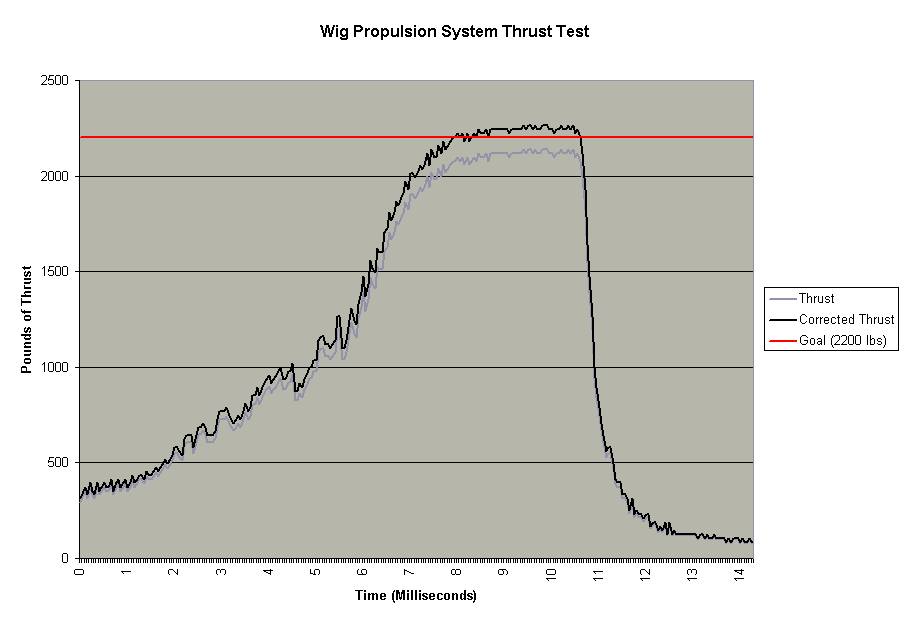
*Note: Corrections made in accordance with SAE J1349, where 77 Degrees Farenheit, 29.235" Hg Altimeter Setting, and 0% Relative Humidity provide a baseline for 100% horsepower and a density altitude of 1946 feet. Average conditions at the time of testing were 85 degrees, 28.99" Altimeter Setting, and 78% relative humidity for a relative horsepower of 94.4% and a density altitude of 3138 feet. For our purposes, we only correct based on the relative horsepower and not the density altitude, although the increased density altitude caused by the test conditions further reduces thrust over ideal conditions. Still, specified thrust is achieved.
Images
Video
The resolution of these videos does not begin to do justice to the sheer terror induced the first you are standing within 30 feet and the engine is taken to 5000+ RPM. The engine itself is surprisingly quiet when you consider that the turbo is dumping through a 5-inch diameter exhaust that is only about 18 inches long. The blades themselves don't really start singing until about 4000 RPM and then it just gets scary. Beyond that the blades begin to condensate water right out of the heavy Florida air (aided by a stream of waste-water from the water-to-air intercooler) and the howl is incredible.
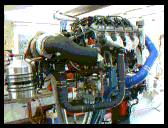 A Walk-Around (7.1 MB / 44 Seconds)
A Walk-Around (7.1 MB / 44 Seconds) Test 1 (2.6 MB / 16 Seconds)
Test 1 (2.6 MB / 16 Seconds) Test 2 (2.1 MB / 13 Seconds)
Test 2 (2.1 MB / 13 Seconds) Test 3 (9.4 MB / 59 Seconds)
Test 3 (9.4 MB / 59 Seconds) Test 4 (5.2 MB / 33 Seconds)
Test 4 (5.2 MB / 33 Seconds) Test 5 (5.7 MB / 36 Seconds)
Test 5 (5.7 MB / 36 Seconds) Test 6 (5.6 MB / 35 Seconds)
Test 6 (5.6 MB / 35 Seconds)
Credits
Key Members (in chronological order)
Instrumental Supporters (in chronological order)
David Hartz, President, Water Thunder Performance - David was our "no problem" guy. No matter what we needed, his response was "No problem." Can you take our Korean clients out airboating? Can you help us identify the right reduction drive and propeller? Can you host the thrust test device testing at your shop? Can you lend us Shawn Dickens to help with some stuff? "No Problem!"
Mark Miller - Mark hosted the construction of the thrust test device at his shop. Drawing from years of race car engineering and building, as well as from his experience as an engineering technician at Hills, Inc., Mark not only did what we needed, he usually was the one that came up with the better idea.
David Strum - How many guys do you know that can dis-assemble the firmware in a Mitsubishi Galant ECU just so that they can say they did? That's the kind of detail you want in the guy that does all of the ECU wiring, provides the start-up tune, and lends assistance during the test phase.
Cal Hartline - Widely proclaimed as one of the top F.A.S.T. tuners in the world, it was all too convenient that Cal lives right here with us in Melbourne.
Bud Bell, President, Classic Airboats - Bud graciously hosted a visit from the KORDI staff so they would have the opportunity to see inside the manufacturing process of the gear reduction drives. He then was available whenever we needed anything.
Victor Mojica, Senior World Sales & Shipping Agent, Federal Express - Ever wonder if you can air-freight a nearly 1-ton, 82-inch cube WIG propulsion system to South Korea? No problem if you're dealing with FedEx.

